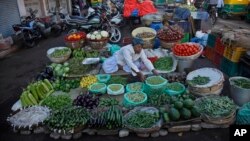Like tens of thousands of others, 33-year-old development consultant Shubhra Jain had high expectations from Prime Minister Narendra Modi’s government when it took power a year and a half ago.
“There was such a sense of, my God, things are going to dramatically change whether it is economy, whether it is governance, whether it is just doing business,” said Jain.
Going by numbers, her expectations have been fulfilled. India overtook China as the world’s fastest growing large economy this year as growth accelerated to over 7 percent, and forecasts say it will retain the top slot next year.
But economists caution that despite those headline-grabbing numbers, there are only nascent signs of a full-scale economic recovery in India.
That is why Jain is no longer euphoric. “Definitely a little bit of realism has come in,” she said.
Indeed, there are few signs of the kind of economic boom India witnessed some years ago — high consumer spending, skyrocketing real estate prices, fat pay rises and rapid expansion of corporates.
Economists say although the economy is picking up momentum, the pace is still slow. Inflation has been tamed — it has come down from about 10 percent two years ago to less than six per cent this year. India, a huge oil importer, has reaped windfall gains from falling crude prices.
But a push by the business-friendly Prime Minister Modi to turn India into an investment hub has had little impact. In September, at a meeting of the heads of India’s biggest industries, he urged them to take risks and invest, but so far, there are not many taking his advice.
Chief economist at ratings agency, Crisil in Mumbai, Dharmakirti Joshi, said that the “private sector is yet to open its purse strings. Most companies right now they are straddled with excess capacity. The utilization of capacities that they created in 2009 or 2010, 2011, is very low. Second reason is some of these companies in the private sector, have a huge debt burden which is only becoming worse.”
As a result, it has been left to the government to give a push to the economy by hugely stepping up spending on infrastructure projects such as roads and in economic sectors including defense and railways.
That is helping to create jobs in some sectors such as retail and infrastructure, said Kris Lakshmikanth at recruiting agency Head Hunters India.
“For almost one year there was no hiring, but now last six months we are seeing changes are happening. It has been improving month after month, the trend is very positive. It is for some the best of times, and for some it may not be the best of times.”
There is a silver lining in other areas also. In a country whose economy is heavily dependent on domestic consumption, consumer spending is on the rise, particularly in urban areas. India has remained insulated from the global slowdown, largely because its economy is not export dependent and relies on its own market of 1.2 billion people.
It was with an eye on this massive market that some overseas companies entered India — American clothing retailer GAP and Swedish retailer H&M opened stores in the country in recent months. Two major technology firms, Foxconn and Xiaomi, also committed to spend billions of dollars to build factories in India.
The automobile industry, a key barometer of the economy, was also upbeat as it clocked growth after two years of plummeting sales.
Vishnu Mathur, the head of the Society of Indian Automobile Manufacturers said they did not achieve the peak levels seen in 2012, but customers lined up to pick up cars and commercial vehicles.
However sales of vehicles such as motorcycles and tractors that sell in rural areas are still in the doldrums. “We have seen not very good monsoons for the last two times, and this time also monsoon has not been too good. That I think is weighing down on the rural demand. We have to be conscious of the fact that the rural demand is now a pretty significant part of our overall demand,” said Mathur. Two-thirds of India still lives in rural areas.
Economists say a pick-up in growth next year will depend partly on a normal monsoon, which could revive rural demand, as well as whether Prime Minister Modi will be able to usher in market reforms, which have been stuck due to opposition from rival political parties.
But while there is some uncertainty going into the next year, the United Nations in its latest report, World Economic Situation and Prospects, forecasts that India will remain the world’s fastest growing economy in 2016.
That is why Shubhra Jain remains optimistic. “Dramatic change is definitely I think not going to happen, but I am still hopeful that we have moved in the right direction,” she said.









